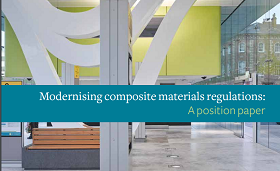Modernising composite materials regulations
In April 2017, a report was published calling for industry and government to work together to tackle the constraints on the use of composite materials in construction and offshore engineering.
‘Modernising composite materials regulations’, published by the University of Southampton, claims that inappropriate standards and regulations are holding back an approach that could be worth £4bn by 2030 if ‘barriers to innovation’ were removed'.
The first-of-its-kind study was carried out by a multi-disciplinary team from the University of Southampton, and its findings are supported by a number of leading organisations, including the Composites Leadership Forum and Composites UK.
The report recognises that the UK is a global leader in the research and development of composite materials and structures, but points out that bringing new products to market could be made much easier.
It proposes modernising the current regulations to enable industry to migrate from current systems of assurance, based on material ‘equivalence’, to a performance-based system. This would harmonise the regulatory regime for composite materials across all sectors, and galvanize manufacturing in the UK.
The global market for composite products was $68bn in 2013 and this is predicted to grow to $105bn by 2030. The UK’s current market share is £2bn.
Professor Ole Thybo Thomsen, head of the infrastructure research group at Southampton and co-author of the position paper, said:
“Advanced polymer composite materials have a huge potential to shape the modern world. The use of composites in aerospace and automobile design is now the norm, but they have much broader potential for use in other sectors such as in building and bridge construction, railway and rail infrastructure, as well as marine and offshore. In aerospace alone, 52% by weight of the latest generation of aircraft are now composed of composite materials.”
Professor Simon Quinn, director of the university’s Research Institute for Industry (RiFi) and the lead researcher of the paper, said:
“In the UK there is currently very limited coordination and centralisation of the codes and standards data associated with new composite materials. There is neither a coherent development of certified testing facilities, nor a formal process for different sectors to share information and best practice. These factors have reduced productivity, discouraged research and development and innovation, and significantly increased the time to market for new composite products.”
To download the executive summary of the report, go here.
[edit] Find out more
[edit] Related articles on Designing Buildings Wiki
Featured articles and news
RTPI leader to become new CIOB Chief Executive Officer
Dr Victoria Hills MRTPI, FICE to take over after Caroline Gumble’s departure.
Social and affordable housing, a long term plan for delivery
The “Delivering a Decade of Renewal for Social and Affordable Housing” strategy sets out future path.
A change to adoptive architecture
Effects of global weather warming on architectural detailing, material choice and human interaction.
The proposed publicly owned and backed subsidiary of Homes England, to facilitate new homes.
How big is the problem and what can we do to mitigate the effects?
Overheating guidance and tools for building designers
A number of cool guides to help with the heat.
The UK's Modern Industrial Strategy: A 10 year plan
Previous consultation criticism, current key elements and general support with some persisting reservations.
Building Safety Regulator reforms
New roles, new staff and a new fast track service pave the way for a single construction regulator.
Architectural Technologist CPDs and Communications
CIAT CPD… and how you can do it!
Cooling centres and cool spaces
Managing extreme heat in cities by directing the public to places for heat stress relief and water sources.
Winter gardens: A brief history and warm variations
Extending the season with glass in different forms and terms.
Restoring Great Yarmouth's Winter Gardens
Transforming one of the least sustainable constructions imaginable.
Construction Skills Mission Board launch sector drive
Newly formed government and industry collaboration set strategy for recruiting an additional 100,000 construction workers a year.
New Architects Code comes into effect in September 2025
ARB Architects Code of Conduct and Practice available with ongoing consultation regarding guidance.
Welsh Skills Body (Medr) launches ambitious plan
The new skills body brings together funding and regulation of tertiary education and research for the devolved nation.
Paul Gandy FCIOB announced as next CIOB President
Former Tilbury Douglas CEO takes helm.
UK Infrastructure: A 10 Year Strategy. In brief with reactions
With the National Infrastructure and Service Transformation Authority (NISTA).























